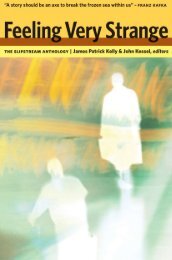The Curse of the Wer.. - Site de Thomas - Free
The Curse of the Wer.. - Site de Thomas - Free
The Curse of the Wer.. - Site de Thomas - Free
Create successful ePaper yourself
Turn your PDF publications into a flip-book with our unique Google optimized e-Paper software.
2 THE CURSE OF THE WEREWOLF<br />
to this interpretation, which remained <strong>the</strong> dominant explanation for<br />
lycanthropy into <strong>the</strong> nineteenth century.<br />
Nineteenth-century scholars’ commitment to <strong>the</strong> principles <strong>of</strong> scientific<br />
inquiry led to o<strong>the</strong>r ‘rational’ explanations <strong>of</strong> <strong>the</strong> phenomenon;<br />
it was argued that belief in <strong>the</strong> werewolf is a superstition originating<br />
in such sources as <strong>the</strong> crimes <strong>of</strong> sociopaths, an atavistic craving for<br />
blood or human flesh, or new mythological patterns brought about<br />
by mistaken word associations (<strong>the</strong> ‘disease’ <strong>of</strong> language studied by<br />
comparative mythologists). Western scholars working in <strong>the</strong> emergent<br />
‘science’ <strong>of</strong> anthropology also revealed that belief in <strong>the</strong> transformation<br />
<strong>of</strong> humans into wolves has animated <strong>the</strong> traditions <strong>of</strong> Native Americans,<br />
who have long coexisted with wolves. This led to speculation that <strong>the</strong><br />
myth had evolved from <strong>the</strong> practice <strong>of</strong> donning animal skins to hunt,<br />
fight or dance. With <strong>the</strong> resurgence <strong>of</strong> interest in <strong>the</strong> occult signalled<br />
by <strong>the</strong> popularity <strong>of</strong> spiritualism in <strong>the</strong> mid- to late nineteenth century,<br />
<strong>the</strong> werewolf was even explained as an actual manifestation resulting<br />
from an individual’s mesmeric projection <strong>of</strong> an astral body.<br />
Most <strong>of</strong> <strong>the</strong>se perspectives were incorporated into <strong>the</strong> representations<br />
<strong>of</strong> <strong>the</strong> werewolf that appeared in <strong>the</strong> Gothic fiction <strong>of</strong> <strong>the</strong><br />
nineteenth century, especially that <strong>of</strong> <strong>the</strong> fin <strong>de</strong> siècle, and in <strong>the</strong><br />
twentieth century such representations were elaborated in fiction and<br />
film, primarily in <strong>the</strong> genre <strong>of</strong> horror, but also in <strong>the</strong> genre <strong>of</strong> fantasy.<br />
Since <strong>the</strong> mid-nineteenth century, <strong>the</strong> various manifestations <strong>of</strong> <strong>the</strong><br />
werewolf <strong>the</strong>me in mythology, folklore, historical records, anthropological<br />
and ethnographic accounts, medical and psychiatric records,<br />
literature and film have also been periodically collated and analysed<br />
in books and articles by both popular and aca<strong>de</strong>mic authors.<br />
Regardless <strong>of</strong> genre, material relating to <strong>the</strong> werewolf in every<br />
period has been informed by prevailing cultural values and dominant<br />
ways <strong>of</strong> knowing or speaking about <strong>the</strong> world. In this sense, texts about<br />
werewolves can be read as indices <strong>of</strong> <strong>the</strong> way in which ‘reality’ has been<br />
assessed, <strong>de</strong>scribed and constructed at different moments in history.<br />
In<strong>de</strong>ed, <strong>the</strong> i<strong>de</strong>a that reality is ‘posited’ and can <strong>the</strong>refore be contested<br />
and revised through rational argumentation was a key bequest <strong>of</strong> <strong>the</strong><br />
Enlightenment, a <strong>the</strong>me that Chapter 1 explores in relation to <strong>the</strong>





